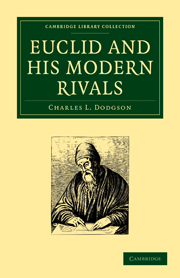Summary
Treatment of Parallels by methods involving infinite semes.
LEGENDRE
‘ Fine by degrees, and beautifully less.’
Nie. I lay before you ‘Éléments de Géométrie’ by Mons. A. M. Legendre, the 14th edition, 1860.
Min. Let me begin by asking you (since I consider you and your client as one in this matter) how you define a straight Line.
Nie. As ‘the shortest path from one point to another.’
Min. This does not seem to me to embody the primary idea which the word ‘straight’ raises in the mind. Is not the natural process of thought to realise first the notion of ‘a straight Line,’ and then to grasp the fact that it is the shortest path between two points?
Nie. That may be the natural process: but surely you will allow our definition to be a legitimate one?
Min. I think not: and I have the great authority of Kant to support me. In his ‘Critique of Pure Reason,’ he says (I quote from Meiklejohn's translation, in Bonn's Philosophical Library, pp. 9, 10), ‘Mathematical judgments are always synthetical … “A straight line between two points is the shortest” is a synthetical proposition. For my conception of straight contains no notion of quantity, but is merely qualitative. The conception of the shortest is therefore wholly an addition, and by no analysis can it be extracted from our conception of a straight line.’
- Type
- Chapter
- Information
- Euclid and His Modern Rivals , pp. 54 - 58Publisher: Cambridge University PressPrint publication year: 2009First published in: 1879

